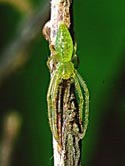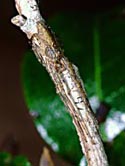|
Family: Thomisidae (crab spiders)
Life
> Eukaryotes
>
Opisthokonta >
Metazoa
(animals) > Bilateria > Ecdysozoa > Panarthropoda > Tritocerebra >
Arthropoda > Arachnomorpha > Cheliceriformes > Chelicerata > Euchelicerata
> Arachnida > Araneae
> Araneomorpha
The Thomisidae, or Crab spiders are the masters of ambush
and disguise. They range in size from 3-32 mm although they rarely exceed 11mm
in body length. This large family includes 38 genera in South Africa and occurs
on all continents except Antarctica. They are called crab spiders because of
their crab-like appearance and sideways motion. They occur more commonly on
plants, sometimes under rocks and are harmless to man.
The family name is derived from the Greek "thomis" means "a
sting".
Genera indigenous to southern Africa
Ansiae
1 species. |
|
Avelis
1 species. |
|
Borboropactus
2 species. |
|
Camaricus
3 species. |
|
Cynathea
1 species. |
|
Diaea
2 species. Very similar to Synema but
without the mask on the abdomen. Diaea is derived from the Greek "dia" means
"during" and "ea" means "spring" |
|
Firmicus
2 species. |
|
Heriaeus
5 species. |
|
Heterogriffus
1 species. |
|
Hewittia
1 species. |
|
Holopelus
2 species. |
|
Misumenops
1 species. |
|
Monaeses
6 species. |
|
Oxytate (grass crab spiders, green crab
spiders)
5 species. Oxytate, previously known as Dieta, is long and
slender and colouration varies from pale cream to translucent green
sometimes freckled with lighter spots. The female's shape and colour afford
effective camouflage among grasses and stems. Oxytate rests on grass
with anterior legs outstretched forward and hind legs next to the body
holding on. |
 |
Ozyptila
1 species plus 1 undescribed. Terrestrial. |
|
Pactactes
3 species. |
|
Parabomis
2 species. |
|
Paramystaria
1 species. |
|
Parasmodix
1 species. |
|
Phaenopoma
1 species. |
|
Pherecydes (stalky-eyed crab spider)
Phercydes with 5 species known from South Africa are long bodied and
cryptically coloured in mottled greys, browns and black which affords
camouflage on the bark of tree trunks. the eyes are on raised tubercles
hence the colloquial name stalky-eyed crab spider. |
|
Phrynarachne
2 species. |
|
Platythomisus
4 species. |
|
Runcinia
8 species. |
|
Simorcus
3 species. |
|
Smodicinus
1 species. |
|
Stephanopis
1 species plus one undescribed. |
|
Stiphropella
1 species. Terrestrial. |
|
Stiphropus
4 species. Terrestrial. |
|
Sylligma
1 species. |
|
Synema (masked crab spiders)
11 species. Synema has a green to brown prosoma (cephalothorax -
anterior body segment including legs) and cream round to oval abdomen
adorned with what looks like a brown skull. This colouration affords a good
camouflage in vegetation. Synema is more active in its prey capture
as it hides amongst the vegetation and dashes out to surprise an
unsuspecting insect. |
 |
Talaus
1 species. |
|
Thomisops
6 species. |
|
Thomisus (flower crab spiders)
15 species. The most conspicuous genus in the family. Spiders are short and
squat, ranging in size from 3-11mm. Sits next to flowers and ambushes
insects just about to land on the flower. It is able to undergo white to
yellow or pink colour changes depending on the flower it is sitting on. The
first and second pairs of legs are noticeably longer and thicker than the
last 2 pairs and are used for prey capture. The abdomen is triangular in
shape, being widest posteriorly. The lateral eyes are situated on tubercles. |
 |
Tmarus (bark crab spiders)
Long-bodied and cryptically coloured in cream to brown mottled greys, browns
and black which affords camouflage on bark. Tmarus rests on a twig
with anterior legs outstretched forward and hind legs tucked in next to body
holding on. A world wide genus with 9 described species and 1 undescribed in
South Africa. |
 |
Trichopagis
1 species. |
|
Xysticus
9 species. Looks very much like Thomisus but with a round
abdomen and no lateral eye projections. The dull brown colouration affords good
camouflage for its more earthy lifestyle on the ground and under stones. Unlike
Thomisus the male uses silk to secure the female to the substrate before
mating. Ozyptila, Stiphropella, Stiphropus are other terrestrial genera. |
 |
Zametopias
1 species. |
|
Publications
- VAN NIEKERK, P. & DIPPENAAR-SCHOEMAN,
A.S. 2010. A revision of the spider genus Simorcus Simon, 1895 (Araneae:
Thomisidae) of the Afrotropical Region.
African Entomology
18: 66–86.
Text and images by Norman Larsen © |
